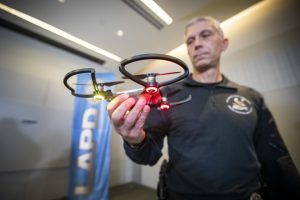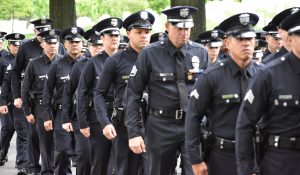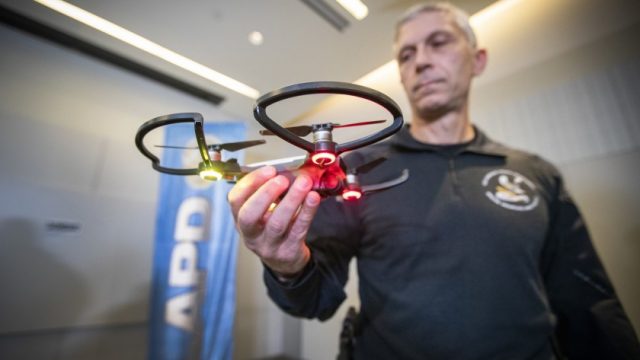
White House to honor LAPD SWAT team
PUBLISHED: May 12, 2009
Fifteen Los Angeles Police Department officers who participated in two gunbattles at a home in Winnetka that left a SWAT officer dead will be honored at the White House today.
The officers were nominated by the Los Angeles Police Protective League for the Top Cops Awards, given by the National Association of Police Organizations.
The officers who will be honored are James Veenstra, David Keortge, Floyd Curry, Tom Chinappi, Mike Barker, Mike Odle, Richard Alba, Mark Nee, Daniel Sanchez, Douglas Dingman, Charles Buttitta, German Hurtado, George Ryan, Anthony Samuelson and Steve Scallon.
They will meet with Obama before the ceremony, said Los Angeles Police Protective League spokesman Eric Rose.
“The officers nominated by the LAPPL are heroes in every sense of the word,” Police Protective League President Paul M. Weber said. “Their focus and courage under fire epitomizes what it means to be a police officer. Modern- day heroes are a rare commodity and these officers live up to the highest standards of the LAPD.”
The incident began around 9 p.m. Feb. 6, 2008 when Edwin Rivera, 20, locked himself up inside the home in the 19800 block of Welby Way after calling police to claim that he had killed family members.
After killing three people, Rivera shot to death SWAT Officer Randy Simmons and wounded Veenstra, also a SWAT officer, before being killed by police in a second shootout hours later, officials said.
“It is a tragedy what happened out there, but it could have been much worse,” Los Angeles Police Department Assistant Chief Jim McDonnell said at the time.
LAPD OFFICERS NOMINATED FOR TOP COP AWARDS
For Immediate Release
Contact:
Eric Rose (805) 624-0572
Jude Schneider (310) 854-8251
Los Angeles, February 2, 2009 –The Board of Directors of the Los Angeles Police Protective League (LAPPL) nominated several LAPD officers from two well-known incidents for the National Association of Police Organizations (NAPO) Top Cops Awards. The Annual Top Cops Awards Ceremony will be held May 12, 2009, in Washington, D.C., during Police Week (May 10-16, 2009).
“The officers nominated this year by the LAPPL are heroes in every sense of the word,” said LAPPL President Paul M. Weber. “These officers’ selflessness and courage under fire epitomize what it means to be a police officer. Modern-day heroes are a rare commodity, but these officers are as close as they come. On behalf the community, we thank them, and we are grateful to their families for supporting their decision to serve all of the community”
The Top Cop Awards pay tribute to law enforcement officers from across the country for outstanding service to their communities during the preceding year. The Top Cops are nominated by fellow officers and selected from hundreds of nominations by an independent awards committee. Officers chosen as the 2008 NAPO Top Cops represent the top ten cases across the country.
SWAT Officer Randal D. Simmons Incident
On February 7, 2008, an incident occurred in the West San Fernando Valley in a normally peaceful neighborhood that would claim the life of one dedicated LAPD SWAT officer, three murder victims, injure several others and result in an outpouring of support for the LAPD by the community in its wake.
The tragic events unfolded when officers received an unknown trouble call at a residence in the San Fernando Valley. Officers Foxhaven and Avalos approached the door of the house and a man’s voice within stated that he had just killed three people and that the officers should come in and kill him. Unknown to officers at the time, a fourth victim, the suspect’s wife, had hidden in the bedroom closet. The officers notified communications and requested more units. More units arrived and set up a perimeter and evacuated neighbors. A series of phone calls were made with the suspect who again insisted that officers should shoot him. Other calls went unanswered, and in some calls movement could be heard in the background.
SWAT was notified. As the officers arrived, they were briefed on the situation. Because it was believed that victims inside the home could still be alive, it was determined that immediate entry was required. A public address (PA) system was used to try to talk the suspect out, but there was no response.
Based on information that the rear of the location had fortified doors, SWAT planned on a front forced entry, with Officer James Veenstra as the team leader and Sergeant Chuck Buttitta as the supervisor. On cue, the SWAT stick went to the front door. Officers Mike Odle and George Ryan were assigned to the front window. Ryan performed a rake-and-break while Odle provided cover. Simultaneously, a breach shotgun was used by Officer Veenstra to force open the door. A flash bang device was tossed in to distract the suspect. Officers Veenstra, David Keortge, Tom Chinappi, German Hurtado, Floyd Curry, Anthony Samuelson and Mike Barker entered the residence. A wall immediately inside the front door impeded vision of the interior and everything was extremely dark.
The suspect was partially hidden behind a doorway and opened fire on the officers with a semi-automatic handgun. Officers Veenstra and Simmons were immediately hit and went down; both officers had been hit in the face. Officer Ogle’s weapon was hit and he received minor wounds to the face and hand. Officers Curry, Chinappi and Barker returned fire and the suspect retreated to an interior bedroom. Officers immediately extracted Veenstra and Simmons while others set up outside the bedroom. Three dead bodies were discovered in the immediate area – the suspect had shot and killed his father and two of his brothers. Officer Steve Scallon and Sgt. Buttitta had by this time also entered the residence and assisted in clearing rooms.
Against their own regulations, rescue ambulances responded to the front of the residence and transported the fallen officers to the hospital. Officer Simmons was pronounced shortly thereafter. The suspect called out to the officers that he had a gun and they should come in and kill him.
Because it appeared that all of the victims in the house were deceased and the SWAT officers were exposed to the suspect’s gunfire inside the residence, it was decided that the situation had transitioned to a barricaded suspect scenario. Officers withdrew from the interior of the residence and set up a perimeter until SWAT equipment and more personnel arrived. Two armored vehicles arrived and the original entry team was relieved by the freshly arrived officers.
Repeated attempts were made to communicate with the suspect with no result. The suspect’s remaining brother was brought in and he pleaded over the PA for the suspect to surrender, again with no results.
Later that morning, the use of chemical agents was approved and SWAT initiated gas from four sides, including the introduction of concentrated gas by breaching a wall with one of the armored vehicles. To everyone’s surprise, the fourth victim (the suspect’s wife) chose this as an opportune time to leave her hiding place in the closet and exit the rear of the house. Officer Richard Alba, assigned as a sniper on an adjacent roof, observed her attempting to exit the residence and the suspect trying to stop her. In defense of her life, he fired one round at the suspect, who disappeared into the interior of the house. The victim ran to safety.
Approximately 30 minutes later, Officers Daniel Sanchez and Mark Nee observed movement in the bedroom window of the house. The suspect’s leg appeared in the window, in an apparent attempt to escape. The officers shouted orders to the suspect to surrender. In response, a gun appeared at the window pointed in the officer’s direction. Both officers fired and the suspect disappeared from the window. The officers believed the suspect had been hit.
Considerable efforts were made to obtain visual contact with the suspect. Finally, Remington “Eyeball” cameras were tossed into the bedroom. Officers could see the suspect moving around; then he appeared to be lying in wait. Flash bangs were tossed into the room and the suspect jumped up and ran out of the bedroom. Unfortunately, the flash bangs also started a fire. The residence, already filled with gas, was now filled with smoke as well. The suspect was seen through the windows approaching the rear door, but he did not exit. Instead he crouched and threatened officers in the rear yard with a weapon. Officers Alba and Officer Douglas Dingman fired, and the suspect went down. An arrest team went in and pulled him out of the burning building, where he was pronounced at the scene.
For their bravery and courage under fire, in extremely perilous and emotionally trying conditions, the Los Angeles Police Protective League is proud to nominate 15 officers from this incident for the NAPO Top Cops Awards. They are:
James Veenstra David Keortge Floyd Curry Tom Chinappi Mike Barker Mike Odle Richard Alba Mark Nee Daniel Sanchez Douglas Dingman Charles Buttitta German Hurtado George Ryan Anthony Samuelson Steve Scallon Attempted Murder of a Police Officer Incident
On February 21, 2008, Officer II Carlos Langarica and Officer II Joe Bain, both assigned to the Northeast Criminal Apprehension Team, were investigating an attempted murder incident and working gangs in plainclothes detail in an undercover vehicle through Drew Street, a well-known gang area. After hearing a police broadcast of a nearby drive-by shooting at Roseview Avenue and Aragon Avenue, the two began monitoring the shooting call. At Estara Avenue and Drew Street, they recognized a white Nissan that matched the description from the broadcast information. Soon after following the suspect vehicle at a short distance, it came to a halt. Suddenly, three gunmen – including one armed with an AK-47 rifle – quickly stepped out and opened fire on the officers. The other two suspects, armed with handguns, also took aim and began shooting straight at Langarica and Bain.
Bain immediately began returning fire through his open door. Langarica, following suit, rolled out of his driver’s side and began firing from a prone position. Before long, the police car was riddled with bullets. The suspect with the AK-47 was killed. A second suspect was wounded and a third escaped. K-9 and SWAT were called to the scene and following a lengthy search, found and arrested the third suspect. Neither Langarica nor Bain were injured. A few days after the incident, a fourth suspect was located and taken into custody without incident. All suspects, with the exception of the one firing the AK-47, who was killed during the standoff, were booked on Murder and Attempt Murder on a police officer charges. The Los Angeles Police Protective League is proud to nominate Officers Bain and Langarica for their bravery and attention to duty, which resulted in the removal of four dangerous criminals from the streets of Los Angeles, for the NAPO Top Cops Awards.
The conduct of these officers in both incidents is representative of the highest traditions of the Los Angeles Police Department.
About the LAPPL: Formed in 1923, the Los Angeles Police Protective League (LAPPL) represents the more than 9,800 dedicated and professional sworn members of the Los Angeles Police Department. The LAPPL serves to advance the interests of LAPD officers through legislative and legal advocacy, political action and education. The LAPPL can be found on the Web at www.LAPD.com
Drones are now a permanent part of the LAPD’s arsenal

LAPD SWAT officer Tom Chinappi at a news conference in January to announce the department’s first use of a drone.
(Allen J. Schaben / Los Angeles Times)
By CINDY CHANG
SEP. 10, 2019 6:08 PM PT
Drones became a permanent part of the Los Angeles Police Department’s crime-fighting arsenal Tuesday, despite opposition from privacy advocates who fear the remote-controlled aircraft will be used to spy on people.
In a yearlong trial, the LAPD’s SWAT team deployed drones four times, mostly when suspects were barricaded and the device provided a bird’s eye view of the property’s nooks and crannies.
On Tuesday, the five-member civilian Police Commission unanimously approved new regulations that enshrine the drones’ use in specific situations, including active shooters, barricaded suspects and search warrants.
The drones will not be equipped with weapons or facial recognition software, according to the regulations, which are similar to those governing the trial program.
In July, at Chief Michel Moore’s recommendation, the use of drones was expanded beyond SWAT to include the bomb squad in neutralizing explosives and sweeping large public events for radioactive devices.
Drones “provide invaluable information to decision makers while decreasing the risk to human life,” Moore wrote in a July 3 report, noting that everyone is safer when the devices check out a dangerous situation instead of officers going in blind.
The LAPD joins about 600 other law enforcement agencies around the country that use drones, according to a 2018 report by Bard College’s Center For the Study of the Drone.
The new regulations will ensure that the drones are not “being used in a flippant manner,” Asst. Chief Horace Frank, who runs the department’s counter-terrorism and special operations bureau, told the Police Commission on Tuesday.
The LAPD’s drone regulations are more restrictive than those of many other agencies, Frank said. Each drone deployment must be approved by a commander and a deputy chief, and the Police Commission will receive an annual report.
Asked by Commissioner Eileen Decker whether drones can help de-escalate volatile situations, Frank cited a June 15 incident when a drone flew near a man who had barricaded himself in a trucking yard.
“The minute we deployed the device at the entrance to the trailer and he saw it, he gave up,” Frank said.
Activists said the LAPD and Police Commission have disregarded citizens who expressed reservations about the drones in community meetings and online surveys.
One activist, Michael Novick, predicted that the LAPD would expand drone usage and infringe on civil liberties.
“We’re witnessing the exact definition of mission creep,” Novick said. “Now you’re upgrading. You approved a temporary pilot project. You’re going to normalize it with this step. … The next step will be they’ll come back and say, ‘We actually need the ability to have facial recognition.’”
The LAPD’s drone fleet will remain at four strong, Frank said. But the DJI Spark devices used in the pilot program will be replaced by DJI Mavics, which have better indoor flying capabilities, extended flight time and lights for navigating in the dark. The models are similar to those used by hobbyists.
The Police Commission accepted a $6,645 donation from the Los Angeles Police Foundation to purchase the Mavics, as well as a donation of drone flight tracking software from Measure Aerial Intelligence.
As the commission approved the drone regulations and donations, the audience broke into chants of “Shame! Shame!”
Moore said he is mindful of “concerns of Big Brother and invasion of privacy and civil liberties.”
“We’re committed to striking the right balance that … protects all of our community — their rights of privacy but also their public safety and their right to exist without threats of dangers that this tool can be used in some instances to mitigate,” he told reporters after the meeting.
Cindy Chang is an assistant city editor for the Metro section. She came to the Los Angeles Times in 2012, first covering immigration and ethnic communities before moving to the L.A. County sheriff’s beat and then the LAPD. Previously, she was at the New Orleans Times-Picayune, where she was the lead writer for a series on Louisiana prisons that won several national awards. A graduate of Yale University and NYU School of Law, she began her journalism career at the Pasadena Star-News.

